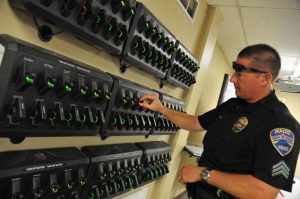
Police departments today process a tremendous amount of video footage as evidence of crimes, which includes managing and storing data and ensuring it is court admissible.
Further, storage requirements for surveillance and body-worn camera data differ widely from state to state, depending on the crime. Each state is different as far as what the law mandates for the length of retention for the data collected. Minor traffic stops may only need to be kept for 30-45 days, DUI’s for over three years, and Federal crimes may need to be kept for many years or in some cases, indefinitely.
Organizations must think beyond three-year or five-year buying cycles and consider how they will manage and store this video for 25 years or more—on-premises versus in the cloud.

With more than 10 million arrests made in 2016 alone – excluding those for traffic violations – body-worn camera data adds up to a lot of storage. On average, each body cam can expect to require a minimum of 1TB of storage per year. And body cameras are just one component of the video data that police departments are tasked with managing.
In fact, currently there’s a litany of other technologies used by police department and officers collecting evidence. This includes video, surveillance cameras, drones, in-car video, mobile devices as well as cell phone downloads to even complete mirror images of hard drives—potentially terabytes of information.
Choosing the right storage solution requires a clear understanding of the costs associated with long-term storage, how quickly a particular police department will need access to evidentiary support, the product life cycle, and legislative storage requirements.
Because of the diversity of digital data collected, police departments must build a data platform that can collect, store and manage individual pools of data. Not addressing the different video storage needs holistically can lead to big challenges for agencies down the line, and create an overwhelming issue for the agency to manage its data long-term.
Keep Your Architecture Options Open
Many agencies have invested in programs that create, utilize, or provide data that is proprietary and cannot be manipulated. To avoid the risk of limiting video to a single company’s platform, departments should bypass a closed solution as it may prevent other key applications gaining access to that data.
Because the video world is constantly changing, an open platform will enable departments to implement the best solutions today and tomorrow. Open platforms enable departments to integrate body cam data with the best available industry applications. Open platforms also provide the scalability and flexibility that agencies need without binding them to separate cloud storage solutions.
Ultimately, using an open platform data management system can be a cost effective approach that will ensure various file types are maintained, usable, and meeting an agency’s needs for years to come.
Understanding Your Surveillance Storage Architecture Options
Storage is the foundation layer of any surveillance solution. However, many organizations purchase body-worn and other surveillance devices before they consider storage requirements or cost. This foundation layer must support an open platform capable of managing disparate data sets (from multiple devices) while addressing the challenge of scale head-on. It is important to understand the differences among the three major surveillance storage architectures— distributed, centralized, and cloud—and what option would be most suitable to your specific organizational needs and requirements.
Distributed architectures: High bandwidth, reliable, affordable
Typically support several hundred surveillance devices. They store video and surveillance data locally and then periodically transfer the digital data set to the central platform. For example, a ‘satellite’ police station may store data locally in office, then periodically transfer it over to headquarters—the centralized location. Distributed architectures often integrate the data with applications and other systems, such as access control and intrusion detection, without engaging a central server. The resulting architecture reduces single points of failure and distributes processing requirements over many, smaller sites.
Centralized architectures: Massive-scale, analytics ready
Commonly used by police headquarters, schools, Federal/government, airports, and energy companies. For example, centralized surveillance architectures host high camera- or device-count environments (typically thousands of surveillance devices) and are able to support large amounts of surveillance data. Storage must be made efficient, and utilization rates must be high to prevent price creep, while migration time must be extremely low to non-existent to seamlessly apply changes in resolution or pixilation.
Cloud architecture: Faster infrastructure deployment, elastic
Many companies opt to go on-premises for their primary storage, but use cloud architectures for deeper ‘cold’ storage. Cloud provides an elastic storage platform that easily expands as data volumes grow. For surveillance-specific industries, this means expanding volumes in a centralized private cloud or even leveraging public cloud storage for more rapid capacity expansion. Ultimately, cloud storage can improve storage efficiencies and help reduce the costs associated with storing inactive data on more expensive storage solutions.
Choosing a vendor that offers both cloud and on-premises storage architectures is a better bet as it will safeguard an organization’s assets while allowing for future growth. Many companies opt to go on-premises first with the bulk of their ‘cold’ or long-term storage, and then go to the cloud for deeper storage. This approach is often more cost-effective, provides greater security, and simplifies application integration.
Dell’s open, hybrid architecture—built on both on-premises and cloud technologies—gives organizations the flexibility and scale they need to seamlessly scale their body-worn and surveillance solutions not only in the immediate future, but long-term as well as requirements and regulations change. It also enables organizations to manage data from a host of other applications such as crime lab, digital evidence, surveillance, drones, in-car, license plate recognition, interview room rooms, crime scene footage, and more.